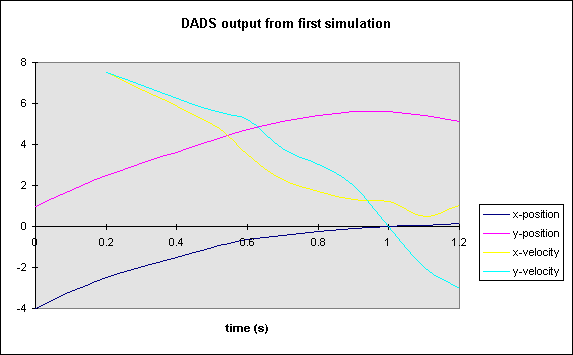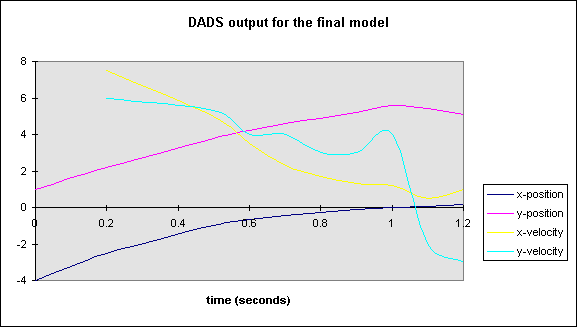The Dynamics of the Pole Vault
introduction | initial model | simulation | final model | conclusion
Introduction
Pole vault is an event in track and field where an athleteís task is
to get his entire body over a cross-bar without knocking it off, and using
only a single pole and his body. All of the energy used by the vaulter
to clear the cross-bar must come from the athlete. The vaulter makes
use of the runway to obtain his maximum velocity before take off.
From the vaulterís velocity at take off, his mass has an initial kinetic
energy associated with it. Although, most of the energy in the system
is due to the vaulterís initial kinetic energy, the vaulterís muscles are
able to put additional energy into the system once he has left the ground.
Initial Model
The initial model only factors in the kinetic energy of the approach
of the vaulter. Using this model, the following assumptions are made:
1. The only energy put into the system is the kinetic energy of the
vaulterís mass.
2. Maximum height is obtained when his kinetic energy is equal to zero
(a point of instantaneous zero velocity).
3. No loss of mechanical energy (all kinetic energy is converted directly
to potential energy).
4. No energy losses in the pole (perfect elastic member).
5. No energy losses between the vaulterís take-off foot and the ground.
Using a simple energy balance of kinetic and potential energy, and following the assumptions, the maximum height of the vaulter is given by h = v2/(2*g); where h is the maximum height, v is the velocity of the vaulter at take off and g is the acceleration due to gravity (9.81 m/s2). If all of my assumptions were valid, then the maximum height of a vaulter is only a function of the square of his velocity. Also, for a given vaulterís maximum velocity he could only obtain the following height:
|
|
|
|
|
|
|
|
|
|
|
|
|
|
|
|
|
|
|
|
|
|
|
|
|
|
|
|
|
|
|
|
|
|
|
|
|
|
|
|
|
|
|
|
|
|
|
|
|
|
|
|
|
|
|
Closed formed solutions for all torques and displacements are nice to have, but they are often tedious and impractical (as in this case). Simulation software packages are available to calculate these parameters using numerical methods. DADS (Dynamic Analysis and Design System) is one such package. The first model that I simulated on DADS is identical to that I analyzed using the Lagrangian method. An initial velocity of 9.5 m/s was given to the vaulter. Graph I shows the data collected from the simulation.

Final Model
In my initial model I made many assumptions to simplify my model.
In reality, some of these assumptions are not good approximations.
Assumption 5 (No energy losses between the vaulterís take-off foot and
the ground.) is a pretty poor assumption. Ideally, the vaulter would
like to take off at 45 degrees from the horizontal. That would mean
that within one step, the vaulter would change his momentum from going
totally horizontal to an angle of 45 degrees to the horizontal. This
is a tremendous impulse on the foot ( about 700 kg*m/s). In reality
take off angle is somewhere around 20 degrees to the horizontal.
Even then the impulse is quite large and energy is lost (the vaulter will
slow down at take off) due to this effect.
Assumptions 3 and 4 are actually quite accurate (No loss of mechanical energy (all kinetic energy is converted directly to potential energy). and No energy losses in the pole (perfect elastic member).). The efficiency of the pole is probably at least 95%.
Assumption 2 (Maximum height is obtained when his kinetic energy is equal to zero (a point of instantaneous zero velocity)) is not exactly accurate. The vaulter needs some horizontal component of velocity to go over the crossbar (so he does not fall on it). But the velocity is usually small (about 2 m/s), and since kinetic energy is proportional to the square of the velocity, his kinetic energy at maximum height is less than 5% of his total energy.
So far all of the assumptions seem to help the theoretical vaulter (he can jump higher with these assumptions). But yet our calculated maximum height is significantly less than the world record. The additional height is gained when assumption 1 is no longer used (The only energy put into the system is the kinetic energy of the vaulterís mass.).
The final model allows energy to be put into the system after the vaulter has left the ground. The additional energy is provided by his shoulders. His shoulders provide an input torque that: raises his center of gravity by some additional amount, and creates some additional rotational kinetic energy.
For the final model the pole was divided into 5 equal sections and given
4 rotational springs. Also, the body of the vaulter is modeled as
a six-bar linkage. The six bars are
· top link of the pole
· right fore arm
· left fore arm
· right upper arm
· left upper arm
· mass of the vaulter
The DADS simulation was set up similar to before with the following results in graph II.

Conclusion
The maximum height that a pole vaulter can obtain is heavily depends
on his initial velocity. This is where he gets most of his energy.
But, once he takes off of the ground it is possible for him to put some
additional energy into the pole. Theoretically, if a vaulter is able
to take off from the ground at 9.5 m/s, and able to supply additional energy
efficiently to the pole, he could jump 20.7 (20í 8 1/2 Ďí).
introduction | initial model | simulation | final model | conclusion
TOP OF PAGE | BACK to engineering credentials | BACK to engineering projects | JAMES' HOME
last modified 1 august 2000